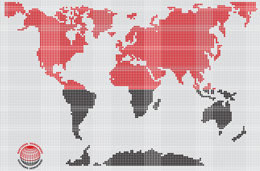Compass Zones
In order to give an accurate bearing a compass needle must be free to move in all directions without ever touching the compass housing. This is not just left and right but also up and down within the compass housing depending on where on the planet you are. These two planes of movement are called inclination and declination. For the needle to be accurate for declination (horizontal plane) , the needle needs to be horizontal within the compass housing (inclination). Compass manufacturers balance their compass needles to be accurate within geographical zones which they themselves set. There are no industry standard zones but as Silva are the dominant manufacturer their zones are often used by other people. The most important thing to know is which zone your compass is balanced for. If you use it far outside this zone it will become inaccurate. There are Globally Balanced compasses which remain accurate anywhere in the world, a good choice for extensive travellers, but they are more expensive than zoned compasses.
SUUNTO
Suunto use either a 2 zone system or a globally balanced compass needle. As you can see from the diagram, the two Suunto zones are the northern and southern hemisphere, so a Suunto Zone 1 Northern Hemisphere compass has a greater accurate zone than a Silva Zone MN compass, however if you are travelling extensively the best bet is a globally balanced needle. One important point to note is that a Suunto Zone 1 compass is good for arctic use, where as a Silva Zone MN compass is not.

